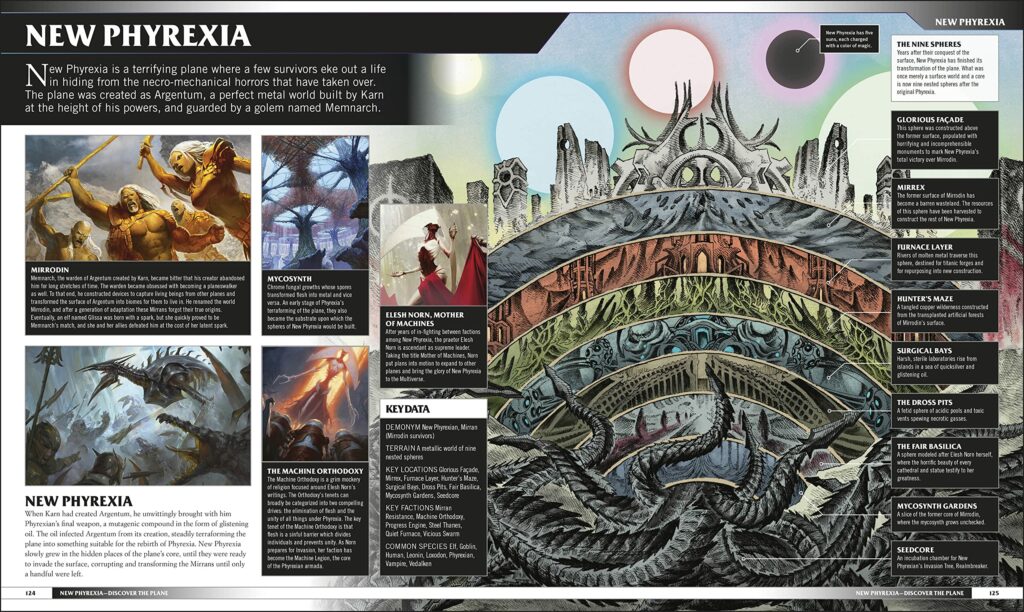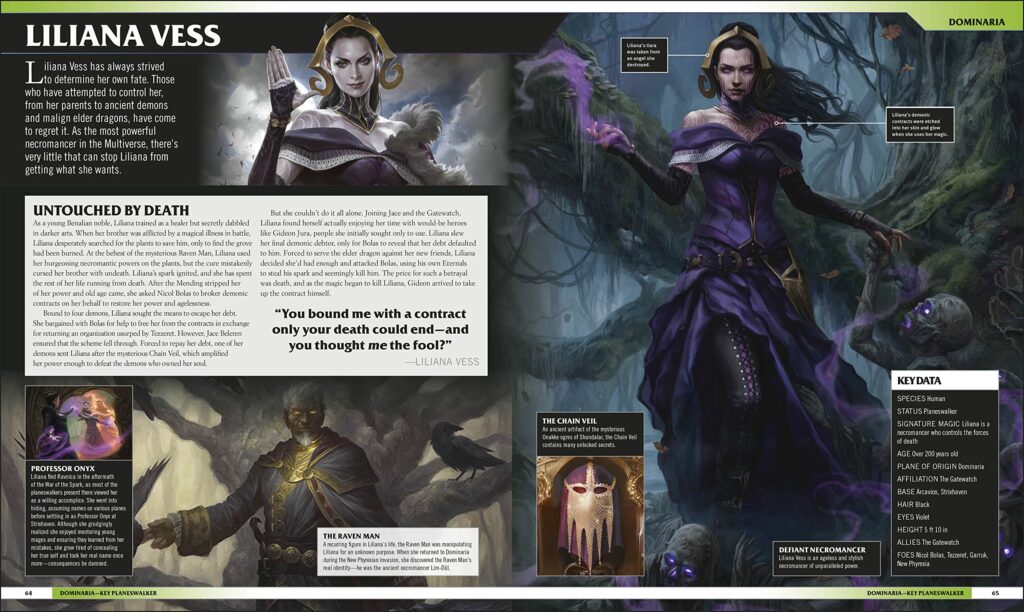In 1998, Lizz Baldwin and Richard Garfield published the first volume of The Art of Magic: The Gathering, featuring art from The Rath Cycle: Tempest, Stronghold, and Exodus. Reflecting Wizards of the Coast’s new approach to narrative design and world building, the art guide featured blown up concept and card art. This came with accompanying text to help players immerse themselves in Magic’s then-recent narrative world. After a long hiatus, James Wyatt revived this concept in 2016, working on art and concept guides for Innistrad, Zendikar, Kaladesh, Amonkhet, Ixalan, Dominaria, Ravnica, for the set War of the Spark, and a broader guide entitled The Art of Magic: The Gathering: Concepts & Legends. These gorgeous volumes featured lavish presentations of lore and art, including two page spreads (approx. 20” wide) of key pieces. They brought behind-the-scenes articles and encyclopedic entries on planar geography, history, and current goings on in Magic story.
In 2019, Magic the Gathering launched a new iteration of this concept. This introduced the Visual History series, including, Rise of the Gatewatch: A Visual History by Jenna Helland (2019), and Legends: A Visual History (2020), and Planes of the Multiverse: A Visual History (2021) by loremaster Jay Annelli. As the name suggests, The Visual History series focused primarily on how broader topics (the Gatewatch, legendary characters, and planes) have been represented in Magic’s art over the years, with a bias toward recent art. Beyond the shift in focus, the Visual Histories were only 60% the size of the previous art books series. They greatly diminished the size of art and the depth of description which could fit inside; a fact even glowingly positive reviewers seldom failed to note.
Last week, DK / Penguin Random House released the latest iteration in Magic’s line of visual guides, again written by Jay Annelli. Few people inside Wizards or out have a more thoroughgoing knowledge of Magic lore than Annelli. This, his third work of this kind, is surely his best yet. Magic: the Gathering – A Visual Guide returns to the oversized printing of Wyatt’s Art of Magic series, allowing illustrations to sprawl across each pair of 10 x 12” pages. This is not simply or even primarily an artbook, however, but something more like a visual encyclopedia, organized alphabetically by plane. Eschewing a dust jacket, the book is printed with beautiful wrap-around art by Kieran Yanner, which features several of the game’s most popular planeswalkers and a magical ripple of glimpses into Ixalan, Amonkhet, Theros, Dominaria, Kaladesh, and Ravnica.

With little variation, each entry spends two to four art-rich pages on the respective plane’s denizens, environment, and history, and then 2 pages on each of the planes native planeswalkers. More space is given to Dominaria, to cover the depth of its lore and history. When Amazon initially listed The Visual Guide for pre-order, a number of these 2 page spreads were posted, which lead to some unexpected and unfortunate side effects. A few spreads shared contained story spoilers for the not-yet released Dominaria United – details unknown at the time, like the identity of the Raven Man and Ajani’s completion. Cautious Vorthos readers can now rest easy – all events described within the book appear to have already come to pass! In the forward, Jay Annelli describes the Visual Guide as offering a detailed overview of Magic history up to (but not including) the conclusion of the current story arc against New Phyrexia.

After this brief forward, Annelli offers us a 12-page introduction to the basics of the Magic: the Gathering multiverse. This includes an eight-page presentation of Magic’s timeline, spanning from the Elder Dragon War (-15,000 Mending Era) through the events of Dominaria United and Teferi’s spiritual voyage to the Brothers’ War in 62 ME. While not exhaustive, this section is enough to get players new and old up to speed on the grand picture of Magic’s multiverse-spanning narrative. As we progress through the book, allusions to characters and historical developments mentioned in the history section are presented more fully and in an attractive format, with large full-page images broken up with thumbnails and commentary. This is especially true for Dominaria’s history and planeswalkers, which receive 24 pages, describing five planeswalkers and six major eras of the plane’s history.

The book ends with a brief treatment of lesser known planes: Kylem, Shandalar, and the Plane of Mountains and Seas are all here. This is followed by a short section on the Eldrazi, who move between planes. Finally, there’s a brief section on planeswalkers with unknown origins, such as the enigmatic Ashiok and Aminatou. Most of these pages seem to be sequestered near the back for the sake of keeping a beautiful layout throughout the book. Inserting a single-page entry in the midst of other planes would interrupt the beautiful two-page spreads. Finally, Annelli has helped readers find the information or art they’re looking for with a comprehensive index – always a welcome addition in this academic’s opinion!
If I were to say anything critical about The Visual Guide, it would be at times the presentation of information feels cluttered, even claustrophobic, with too little negative space. Occasional small black text boxes, pointing out design elements in the art (pictured above), in my opinion, were often detractions from and not enhancements of the art presented on the page. Secondly, there is a recency bias: No mention of Ulgrotha or Baron Sengir, Mercadia or Ramos, and only a passing mention of Serra (and as a goddess, not a planeswalker). Personally, I’d have loved to see more on these characters here, especially given recent callbacks in sets like Modern Horizons and Commander Legends. It’s clear that this product was designed not to be the ultimate Magic encyclopedia, but to bring new or returning players interested in the lore up to speed.
Quibbles about presentation and lack of boomer content aside, Annelli has produced a fantastic visual tour of Magic’s people and places. It balances presentation of art and information remarkably well, doing so at a reasonable price. While one can imagine a more comprehensive visual guide, it would be hard to imagine anything more complete fitting in just 200 pages (consider that the art books for Ravnica, Innistrad, et al, were each over 200 pages). Overall, The Visual Guide is a wonderful book for Magic fans, suitable as a coffee table book or as a general lore reference. Find it wherever books are sold.
Jacob W. Torbeck, Ph.D. (he/him) is a researcher and lecturer in philosophy and theology. Jacob hails from the Greater Chicago area, and loves playing Commander and Limited Magic, especially his Old School (93/94) and spooky cubes.

